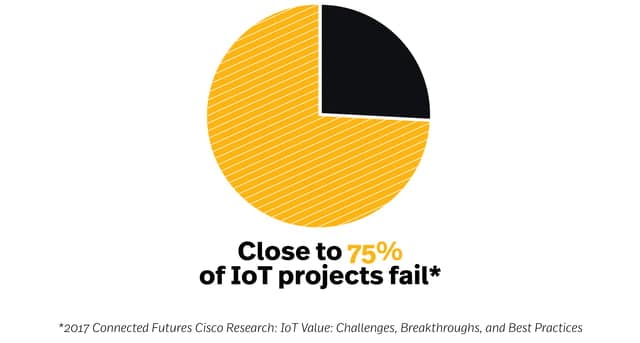BLOG
Why Does IoT Fail? Learning from SigFox and Beyond
Emerging technologies are thrilling. They rouse our curiosity, spark our imagination, and set us dreaming about what solutions we can create to improve the world and generate value for our business. When we venture into this unknown, however, we leave the safety rails behind. We have to invent the future.
This brings risk. This high-risk high-reward equation is the reason that venture capital exists: although most of their investments may fail, the occasional success pulls up the entire portfolio. Companies that sell products, on the other hand, can’t hedge their bets in the same way. To improve their chances of success, they need to follow a rock-solid strategy from beginning to end.
When we zoom in on the internet of things (IoT) industry, we see that nearly three-fourths of IoT projects are failing, according to a Cisco survey. As a team of IoT engineers and business leaders, this got us wondering: why do so many projects struggle, and what can we do to develop devices that are both useful and profitable?

The above survey results were published in May of 2017, and, as we write in January of 2021, a lot has happened in the world of IoT. Three years can feel like ages at the tech edge, and over this time we’ve closely watched the industry grow just as we’ve learned from our own experience as IoT developers.
If there’s one thing that we’ve seen kill IoT projects time and time again, it’s scope creep.
Scope is Everything
We get it. There’s been a lot of hype recently about IoT and how it’s poised to transform our world. Research shows that the number of installed IoT devices is steadily increasing and that more companies are investing in IoT tech. These numbers are projected to grow, and it’s not hard to see how these big numbers translate into hype.
When that hype overtakes sound logic, however, then problems arise. Companies and their leaders want to do too many things at once. Instead of focusing on a specific use case for a target market, too many projects fall into the trap of trying to be everything for everyone. It’s just not possible.
Narrow Your Scope

Think hard about your use case and market. If you set out to create a smart home device, for instance, then your product should reflect that: low price for the mass market, clean aesthetics, and very user friendly.
If we try to switch that halfway through development and say that your product should also be suitable for manufacturers with the industrial internet of things (IIoT), then you’re introducing an entirely new set of priorities. The device needs to be highly secure, ruggedized for extreme environments, and optimized for real-time performance. Suddenly our IoT device is more expensive, doesn’t look as nice, and requires more technical expertise to use.
When we try to split the difference like this, then we end up with a product that nobody wants. These markets have different priorities, and if we want to create a product that’s attractive to a certain group, we need to lean into what they want. Going halfway will only put off both sides.
Instead, develop a good use case with specific requirements at the very onset. Once you’ve made a decision, stick to your guns and complete that project before developing towards the next one.
SigFox: A Near-Failure Example

SigFox is a French company that provides LPWAN infrastructure for IoT connectivity. Essentially, they’re like a cellular service provider but for IoT networks; they handle all the back-end, and anybody can pay a monthly subscription fee to hook their own devices up to the network.
The company had a promising start. In 2016, SigFox raised $160M in venture capital, making it one of the best-funded French startups and a rising star in the nascent IoT industry. They rapidly set out to expand their network into 60 countries, touting their service as the perfect networking solution for each and every IoT device.
It didn’t work out. France’s Les Echos business newspaper ran a story headlined “SigFox turns a painful corner”, as the company was forced to sell off several of its networks and lay off over 10% of employees. The company had tried to be too many things for too many people.
In an interview with VentureBeat, Ajay Rane, SigFox VP of business development, said that,
“One of the difficult lessons SigFox learned in recent years is that it is not the best solution for many use cases. For instance, things like electric metering require continuous data transfer, so utilities are better off using cellular-based transmission. On the other hand, water and gas meters work well with SigFox devices.”
By realizing that they needed to target specific use cases and markets, SigFox was able to bounce back from the brink. The company was able to reinvent itself by narrowing its scope.
“Rather than trying to take a piece of the other people’s pie, we’ve actually expanded the pie itself so that everybody can have a more enriched market access and be able to be successful,” said Rane. “And we’ve done that by focusing on areas where we are strong, and also by learning to say no to other opportunities, where we kind-of-sort-of work but we are not the best solution.”
The Takeaway: The Power of No

It may be tempting to always want to say yes—to new technologies, to emerging opportunities, and to executives who want to expand the scope of their company’s IoT initiatives—but companies need to learn to say no. By saying no to anything that’s not directly serving your purpose, you can stay on track to accomplish your biggest goals.
This doesn’t mean that you should revert to a waterfall methodology. At Very, for example, we practice agile IoT development in our daily work. Agile lets us stay flexible in our choice of technologies, feature priorities, and iterations. Agile excels at enabling a long-term vision because it lets us fill in the blanks more effectively.
That doesn’t mean we should be flexible in our use cases or target market, though. Our long-term goals should remain fixed, and we’ll use agile to find the best path to get there.
Ready to get started? Learn more about our software development services.











